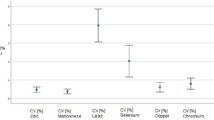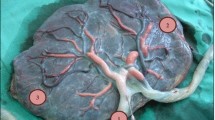Abstract
Environmental pollution and exposure of people to heavy metals cause many bad obstetric outcomes. Our aim is to demonstrate the role of cadmium (Cd), lead (Pb), mercury (Hg), and selenium (Se) in preterm labor etiology with a case-control study. In this study, between November 2017 and April 2018, preterm delivery mothers and term delivery mothers were compared in Çorum, Turkey. All deliveries were performed with cesarean sections and there were 30 mothers in the control group and 20 in the study group. The maternal blood, maternal urine, umbilical cord blood, and heavy metal levels in the amnion fluid in both groups were studied. Graphite furnace atomic absorption spectrometry was used to determine the blood concentration of Cd, Pb, Hg, and Se. We found lower levels of selenium in blood and urine of preterm delivery mothers and umbilical cord and amnion fluids of preterm infants (p < 0.01). We found a statistically significant positive correlation at selenium levels between mother’s blood and umbilical cord blood (r (50) = 0.896, p < 0.001) and between maternal urine and amniotic fluid (r (50) = 0.841, p < 0.001). We have not found a similar correlation between mother and fetus of other metals (p > 0.05). We found that selenium levels were lower in mothers who were preterm birth in the light of the data in our study. We could not determine the positive or negative correlation of Cd, Pb, and Hg levels in blood, urine, and amniotic fluid samples with preterm birth.
Similar content being viewed by others
References
Savitz DA, Blackmore CA, Thorp JM (1991) Epidemiologic characteristics of preterm delivery: etiologic heterogeneity. Am J ObstetGynecol 164:467–471
Flora SJS, Pachauri V, Saxena G. (2011) Arsenic, cadmium and lead. In: Gupta RC, editor. Reproductive and developmental toxicology Elsevier,London,pp. 415–439
Foster WG, Neal MS, Han MS, Dominguez MM (2008) Environmental contaminants and human infertility: hypothesis or cause for concern? J Toxicol Environ Health 11:162–176
Rogers J(2013) Developmental toxicology. In: Klaassen C.D., editor. Casarett and Doull’s toxicology: the basic science of poisons. McGraw-Hill, Health Professions Division; New York, NY, USA
Kjellstrom T, Nordberg GF (1978) A kinetic model of cadmium metabolism in the human being. Environ Res 16:248–269. https://doi.org/10.1016/0013-9351(78)90160-3
Al-Saleh I, Shinwari N, Mashhour A, Rabah A (2014) Birth outcome measures and maternal exposure to heavy metals (lead, cadmium and mercury) in Saudi Arabian population. Int J Hyg Environ Health 217:205–218. https://doi.org/10.1016/j.ijheh.2013.04.009
Sanders AP, Claus Henn B, Wright RO (2015) Perinatal and childhood exposure to cadmium, manganese, and metal mixtures and effects on cognition and behavior: a review of recent literature. Curr Environ Health Rep 2:284–294. https://doi.org/10.1007/s40572-015-0058-8
Vilahur N, Vahter M, Broberg K (2015) The epigenetic effects of prenatal cadmium exposure. Curr Environ Health Rep 2:195–203. https://doi.org/10.1007/s40572-015-0049-9
Rischitelli G, Nygren P, Bougatsos C, Freeman M, Helfand M (2006) Screening for elevated lead levels in childhood and pregnancy: an updated summary of evidence for the US Preventive Services Task Force. Pediatrics 118:e1867–e1895
Greig J, Thurtle N, Cooney L, Ariti C, Ahmed AO, Ashagre T, Ayela A, Chukwumalu K, Criado-Perez A, Gómez-Restrepo C, Meredith C, Neri A, Stellmach D, Sani-Gwarzo N, Nasidi A, Shanks L, Dargan PI (2014) Association of blood lead level with neurological features in 972 children affected by an acute severe lead poisoning outbreak in Zamfara State, northern Nigeria. PLoS One 9:–e93716
Freedman R, Olson L, Hoffer BJ (1990) Toxic effects of lead on neuronal development and function. Environ Health Perspect 89:27–33
Neal A, Guilarte T (2012) Mechanisms of heavy metal neurotoxicity: lead and manganese. J Drug Metab Toxicity S5:002
Hernandez-Avila M, Peterson KE, Gonzalez-Cossio T, Sanin LH, Aro A, Schnaas L, Hu H (2002) Effect of maternal bone lead on length and head circumference of newborns and 1-month-old infants. Arch Environ Health 57:482–488
Llanos MN, Ronco AM (2009) Fetal growth restriction is related to placental levels of cadmium, lead and arsenic but not with antioxidant activities. ReprodToxicol 27:88–92
WHO (2013) Mercury and health. Fact sheet. Geneva, Switzerland: WHO; September
Clarkson TW, Magos L (2006) The toxicology of mercury and its chemical compounds. Crit Rev Toxicol 36:609–662
Mahaffey KR, Clickner RP, Bodurow CC (2004) Blood organic mercury and dietary mercury intake: National Health and Nutrition Examination Survey, 1999 and 2000. Environ Health Perspect 112:–562
Yorifuji T, Tsuda T, Takao S, Harada M (2008) Long-term exposure to methylmercury and neurologic signs in Minamata and neighboring communities. Epidemiology 19:3–9
Barrington JW, Lindsay P, James D et al (1996) Selenium deficiency and miscarriage: a possible link? Br J ObstetGynaecol 103:130–132
Rayman MP, Wijnen H, Vader H, Kooistra L, Pop V (2011) Maternal selenium status during early gestation and risk for preterm birth. CMAJ 183(5):549–555. https://doi.org/10.1503/cmaj.101095
Rayman MP, Bode P, Redman CW (2003) Low selenium status is associated with the occurrence of the pregnancy disease preeclampsia in women from the United Kingdom.Br J Obstet Gynaecol 189:1343–1349
Morris JS, Crane SB (2013) Selenium toxicity from a misformulated dietary supplement, adverse health effects, and the temporal response in the nail biologic monitor. Nutrients 5(4):1024–1057. https://doi.org/10.3390/nu5041024
Helzlsouer K, Jacobs R, Morris JS (1985) Acute selenium intoxication in the United States. Fed. Proc. (FASEB). 44, 7366
Vinceti M, Mandrioli J, Borella P, Michalke B, Tsatsakis A, Finkelstein Y (2014) Selenium neurotoxicity in humans: bridging laboratory and epidemiologic studies. Toxicol Lett 230(2):295–303
Grosicki A, Kowalski B (2002) Lead, cadmium and mercury influence on selenium fate in rats. Bull Vet İnst Pulawy 46:337–343
Whanger PD (1992) Selenium in the treatment of heavy metal poisoning and chemical carcinogenesis. J Trace Elem Electrolites Health Dis 6:209–221
Ganther HE (1980) Interactions of vitamin E and selenium with mercury and silver. Ann N Y Acad Sci 355:212–226
El-Sharaky AS, Newairy AA, Badreldeen MM, Eweda SM, Sheweita SA (2007) Protective role of selenium against renal toxicity induced by cadmium in rats. Toxicology 235(3):185–193
Vogel JP, Lee AC, Souza JP (2014) Maternal morbidity and preterm birth in 22 lowand middle-income countries: a secondary analysis of the WHO Global Survey dataset. BMC Pregnancy Childbirth 14:56
Howson CP, Kinney MV, Lawn J. (2012) Born too soon: the global action report on preterm birth. March of Dimes, PMNCH, Save the Children, WHO
Matusiewicz H (2003) Wet digestion methods. In: Mester Z, Sturgeon R (eds) Comprehensive analytical chemistry. Volume 41: sample preparation for trace element analysis. Elsevier, Netherlands, pp 193–233
Sharma T, Dev Banerjee B, Yadav CS, Gupta P, Sharma A (2014) Heavy metal levels in adolescent and maternal blood: association with risk of hypospadias. ISRN Pediatr 4:714234
Nazemi L, Shariat M, Chamari M, Chahardoli R, Asgarzadeh L, Seighali F (2015) Comparison of maternal and umbilical cord blood selenium levels in low and normal birth weight neonates. J Family Reprod Health 9(3):125–128
Iranpour R, Zandian A, Mohammadizadeh M, Mohammadzadeh A, Balali-Mood M, Hajiheydari M (2009) Comparison of maternal and umbilical cord blood selenium levels in term and preterm infants. Zhongguo Dang Dai Er Ke Za Zhi 11(7):513–516
Tsuji M, Shibata E, Morokuma S, Tanaka R, Senju A, Araki S, Sanefuji M, Koriyama C, Yamamoto M, Ishihara Y, Kusuhara K, Kawamoto T, Japan Environment & Children’s Study Group (2018) The association between whole blood concentrations of heavy metals in pregnant women and premature births: the Japan Environment and Children’s Study (JECS). Environ Res 166:562–569. https://doi.org/10.1016/j.envres.2018.06.025
Karaer A, Tuncay G, Tanrıkut E, Ozgul O (2018) Blood cadmium concentrations in women with ectopic pregnancy. Biol Trace Elem Res 184:42–46
Li J, Wang H, Hao JH et al (2017) Maternal serum lead level during pregnancy is positively correlated with risk of preterm birth in a Chinese population. Environ Pollut 227:484–489. https://doi.org/10.1016/j.envpol.2017.05.009
Zhang B, Xia W, Li Y et al (2015) Prenatal exposure to lead in relation to risk of preterm low birth weight: a matched case-control study in China. Reprod Toxicol 57:190–195. https://doi.org/10.1016/j.reprotox.2015.06.051
Xue F, Holzman C, Rahbar MH, Trosko K, Fischer L (2007) Maternal fish consumption, mercury levels, and risk of preterm delivery. Environ Health Perspect 115(1):42–47
Wai KM, Mar O, Kosaka S, Umemura M, Watanabe C (2017) Prenatal heavy metal exposure and adverse birth outcomes in Myanmar: a birth-cohort study. Int J Environ Res Public Health. 14(11). doi: https://doi.org/10.3390/ijerph14111339
Taylor CM, Golding J, Emond AM (2014) Lead, cadmium and mercury levels in pregnancy: the need for international consensus on levels of concern. J Dev Orig Health Dis 5(1):16–30
Vigeh M, Yokoyama K, Seyedaghamiri Z, Shinohara A, Matsukawa T, Chiba M, Yunesian M (2011) Blood lead at currently acceptable levels may cause preterm labour. Occup Environ Med 68(3):231–234
Menai M, Heude B, Slama R, Forhan A, Sahuquillo J, Charles MA, Yazbeck C (2012) Association between maternal blood cadmium during pregnancy and birth weight and the risk of fetal growth restriction: the EDEN mother–child cohort study. Reprod Toxicol 34:622–627
Tian LL, Zhao YC, Wang XC, Gu JL, Sun ZJ, Zhang YL, Wang JX (2009) Effects of gestational cadmium exposure on pregnancy outcome and development in the offspring at age 4.5 years. Biol Trace Elem Res 132(1–3):51–59. https://doi.org/10.1007/s12011-009-8391-0
Acknowledgments
We would like to thank Çorum Municipality. Our work was supported by the program “I have a project for Çorum” initiated by the Hitit University and the Municipality of Çorum. We would also like to thank Hitit University Scientific Technique Application and Research Center for their help in analysis on samples.
Author information
Authors and Affiliations
Corresponding author
Ethics declarations
Before the start of the study, approval was obtained from the Ethics Committee of the Hitit University Medical Faculty in accordance with the Helsinki Declaration. Informed consent forms were obtained from the patients included in the study.
Conflict of Interest
The authors declare that they have no conflict of interest.
Additional information
Publisher’s Note
Springer Nature remains neutral with regard to jurisdictional claims in published maps and institutional affiliations.
Rights and permissions
About this article
Cite this article
Yıldırım, E., Derici, M.K., Demir, E. et al. Is the Concentration of Cadmium, Lead, Mercury, and Selenium Related to Preterm Birth?. Biol Trace Elem Res 191, 306–312 (2019). https://doi.org/10.1007/s12011-018-1625-2
Received:
Accepted:
Published:
Issue Date:
DOI: https://doi.org/10.1007/s12011-018-1625-2




